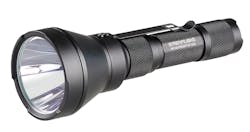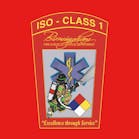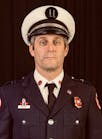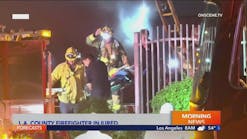INTRODUCTION:
Over the past five years, the fire service has placed a new emphasis on firefighter rescue, an emphasis never before considered to be necessary. Prior to the inception of NFPA 1500 (Standard on Fire Department Occupational Safety and Health Program) and training programs such as "Get Out Alive" and the ever-popular "Saving Our Own" program, few if any firefighters could ever fathom the possibility of needing to rescue one of their own.
As we consider this newfound focus, ask yourself these subtle questions. Have we taken the time to properly prepare our fireground commanders? Have we, as fire instructors and trainers dedicated the necessary time and training to ensure the safe and effective management of a "Mayday!" incident? To most, the answers are unquestionably, NO!
To consider such an event and the subsequent rescue in which a fellow firefighter or firefighters are trapped, lost or disoriented within a structure, to be routine, is to deny the truth. The mere phrase "Mayday!" has forever changed the careers and lives of many dedicated fire service professionals.
The initiation or transmission of a firefighter distress signal produces more stress and potential chaos then any other singular type of incident we may encounter throughout our careers. As firefighters, fire officers, and trainers we must develop a standard plan of action that permits our fireground strategist to properly manage and overcome these potentially chaotic and unquestionably stressful events. Our lives and the lives of our fellow firefighters depend on our preparatory efforts.
This article will provide three critical lessons for every fireground commander to consider as he/she prepares for what might ultimately be the most critical call of their career.
PRESENTATION:
Lessons learned from the recent and distant past continue to serve as our fateful reminders of operational failures and successes. The fire service abroad continues to provide us with detailed technical reports and investigative findings, which provide us with an unending, list of lessons learned. Although very few if any of these reports provide a detailed account of the Safety Engine/RIT deployment operations, one can quickly identify similarities that can be related to the proper management of a "Mayday!" incident.
LESSON # 1 - PREPARATION / PLANNING
The lack of pre-fire planning has claimed the lives of many fire service professionals in the recent past. Today's fire service mangers must use pre-fire planning to serve as a safety net when managing the modern fireground. Proper risk management coupled with a structured firefighter survival program enables the modern firefighter to quickly identify and understand the associated risk he/she is about to encounter. It is through these preparatory efforts that we can provide the modern firefighter with advantages unbeknownst to firefighters of the recent past.
Pre-fire Planning / Pre-fire Analysis - What we do in preparation for ultimately determines the success or failure of our efforts. Case studies have clearly identified that the success or failure of any "Mayday!" incident is a direct result of effective incident management and pre-incident planning. No better preparatory effort can be afforded the modern fireground commander then the pre-fire analysis.
Fire service building construction veteran Francis Brannigan once said, "There is no substitute for the fire department developing a system of accumulating and organizing information for retrieval at the time of the fire. This situation is analogous to military intelligence. It is vital to know the disposition of the enemy." Knowing your enemy is a rule every firefighter and fireground commander should live by. No fireground can ever be made entirely safe, but it goes without saying, if we know the enemy up front the odds of winning the war are dramatically increased in our favor.
Consider the following PRE-FIRE INDICATORS and how they that can potentially lead to a fireground "Mayday!" and/or compromise the Safety Engine/RIT operation:
Weight - Pre-fire indicators of excessive weight in the overhead should be of immediate concern to the fireground commander when deciding whether to deploy additional personnel during a rescue effort. Excessive weight may include such items as: HV/AC units, large billboards, storage tanks, etc.
Fuel Loads - Excessive fuel loads (flammable/combustible) noted in the pre-fire planning are an indication of potential rapid-fire development which may lead to firefighters becoming trapped or overcome firefighters during the initial firefight.
Building history - The history of a building should play a major part in the strategy and tactics deployed at every fire incident. Previous fires, structural collapses, renovations, which are known, and unknown to the fireground commander may lead to the entrapment of firefighters.
Deterioration - A factor of the modern fireground continues to be vacant buildings or buildings of poor repair. As firefighters going through most fire academies we are taught that all buildings are occupied until proven otherwise. As a fireground commander, proper risk management must play a significant part in our decisions to deploy initial crews into an occupancy in which a high potential for firefighter injury or loss exist. Pre-fire planning should enable us to identify which buildings within our response district require absolute defensive operations to support firefighter safety and survival.
Support Systems / Truss Construction - Examples of firefighter fatalities have been shared with the fire service concerning truss collapses for years, from the bowstrings of Hackensack to the lightweight large spans of Chesapeake, bowstring and lightweight truss construction must be of the utmost concern to the fireground commander.
Following a recent lightweight truss collapse in which two (2) firefighters lost their lives, Francis Brannigan was quoted as saying: "Being under a burning truss, is like playing RUSSIAN ROULETTE with a LOADED REVOLVER." As fireground commanders begin to consider deploying Safety Engine/RIT teams for firefighter rescue efforts, careful consideration must be given to the potential of truss collapse, which may very well further complicate if not compound the rescue efforts.
Consider the following ON-SCENE indicators and how they that can potentially lead to a Mayday incident:
- Prolonged burn time, continued or heavy fire throughout the structure
- Smoke showing through walls - extensive structural damage, gas accumulations
- Inadequate ventilation / flammable gas accumulations, potential for rapid fire development
- Sagging floors, bulging walls, interior collapse - major damage to structural integrity
- Water between bricks, excessive water in the building - excessive downward force
- Two or more floors involved in fire - multi-point structural compromise
- Unprotected steel - direct flame impingement of structural components, collapse pending
Additional preparatory efforts that determine the success or failure of a Mayday incident include the following:
Firefighter survival training - Firefighters who have been properly trained in self-survival skills can greatly enhance the possibility of a successful Safety Engine/RIT team rescue. Standardized, predicable actions of a trapped, lost or disoriented member will enable rescuers to locate and extract the member in a much more timely manner.
Standardized self-survival actions:
- Initiate an emergency "Mayday" / Activate Emergency Distress Button
- Stay Calm, Preserve Your Air Supply
- Activate P.A.S.S.
- Provide a situation / problem report
- If trapped or disoriented as a crew, stay together
- Search for an exit - look for light
- Attempt to follow a hose line / life line to safety
- Retreat to an area of safety
- Assume a horizontal position to enhance the audible signal of your P.A.S.S. and enhance thermal protection
- Use your flashlight as a beacon device / Attempt to make tapping noises using tools or other objects.
Fireground Preparations - Proactive fireground preparations for survival cannot be over stated. As was mentioned originally with the introduction of the Safety Engine Concept, proactive fireground operations dedicated to firefighter self-survival help aid in the success and/or prevention of the "Mayday!" incident.
Proactive ladders - Provide secondary means of egress for trapped, lost or disoriented members and serves as an immediate point of access for Safety Engine/RIT personnel.
Four-point scene lighting/Entry-point lighting - Provides enhanced firefighter accountability and directional orientation for lost or disoriented members.
Back-up/Safety lines - Provides an additional line of support incase of rapid-fire development.
Proactive security bar removal - Establishes secondary means of egress for interior crews incase of rapid-fire development or an air supply emergency.
LESSON # 2 - STANDARDIZATION / PREDICTABILITY
The effectiveness of any fireground operation and the overall safety is truly a basis of standardization. Do you have standard operating procedures/guidelines that enable proper decision-making and firefighter accountability? Standardization creates predictability, and predictability enables fireground commanders to manage and forecast the needs of the modern fireground.
Standard Operating Procedures/Guidelines - Well established SOP's/SOG's create operational effectiveness for fire departments across the country. Each and everyday firefighters from different agencies successfully suppress the evils of fire utilizing standardized (proven) suppression techniques. The safe and effective management of a Mayday incident is dependent upon a structured, predictable fireground based on firm rules of engagement.
Incident Management System - The failure of some departments to adopt and enforce a standardized approach to incident management continues to be a contributing factor of firefighter fatalities each year. Strong, early presence of a fireground commander is paramount to effective fireground management. Regardless of your department's size, staffing, response, etc., the first arriving officer should establish command. The idea or concept of passing command to the next company is an open invitation to freelancing. Any fireground that lacks an early command presence is destined for disaster.
Basic Structural Tactical Initiatives - The effective use of Basic Structural Tactical Initiatives (Sept. 2000, Voice) establishes a standardized, and predictable fireground that ensures all necessary actions are properly assigned and completed in an orderly fashion.
Standardized Communications - Fireground communications continues to be on-going problem in the fire service. NFPA 1561 states the communication systems shall meet the requirements of the fire department for routine and large-scale emergencies. Emergency scenes become very hectic within a short period of time. Radio communications occurring between the Incident Commander, attack crews, pump operators, mutual aid companies, and dispatch can easily be missed. It is imperative that on-scene operations be given fireground tactical radio channels that are separate from the normal dispatch frequencies.
Firefighters operating on-scene must be capable of communicating between themselves and the Incident Commander without being talked over by dispatch or other companies. In a small fire department, one radio channel for dispatch and a fireground communications channel might be sufficient for most situations. A larger fire department requires several additional radio channels to provide for the volume of communications relating to routine incidents and for the complexity of multiple alarm situations.
LESSON # 3 - DISCIPLINE / ENFORCEMENT
The deployment of a Safety Engine/RIT is often times the direct result of a sudden hazardous event that inevitably leads to chaos. Strict discipline and strong enforcement enable fireground commanders to adequately account for and assign the necessary crews to complete the task without the fear of freelancing or contradictory actions.
Safety Engine/RIT - In the event of a Mayday incident, physical and mental limitations will be taxed to their limits, rescuers must be forced to follow the rules of personal safety throughout. Firefighters who become involved in a rescue operation oftentimes fail to recognize their personal limitations and may very quickly become victims themselves. Safety Engine/RIT team discipline remains paramount to the safety and effectiveness of the overall operation. Safety Engine/RIT teams who fail to follow the strict directions of the Incident Commander and their respective Safety Engine/RIT Officer will undoubtedly become a victim themselves.
Suppression Personnel Discipline - The desire to be involved plays a critical part in all fireground operations. As the initial arriving company to a working structure fire, everyone wants to be part of the action, it's human nature, it's our training and the overwhelming culture of the modern fire service. "Mayday!" incidents in which the Safety Engine/RIT is deployed, like so many others bring about an uncontrollable magnetism to the action. Personnel assigned to fire attack/suppression operations must overcome the desire to get involved. As tough as it may be, strict discipline must be enforced to ensure proper accountability. Previously assigned fire attack/suppression crews must maintain their position in order to limit the threat of flame impingement on the trapped or disoriented firefighter(s).
A trapped or disoriented firefighter has two factors working against him/her, limited air supply and flame impingement barring the fact that direct physical trauma is not involved. Fire suppression or attack personnel serve as a safety blanket for the trapped or lost member(s). Suppressing or limiting the fire spread enables rescuers to initiate the necessary search or extrication efforts without having to fear being overrun by fire; although this action is easily described, the reality is the temptation is overwhelming to abandon the hose line to help our fallen comrade. Strict discipline and personal confidence must be instilled in each of our firefighting crews. Simply stated, we have a job to do, and we all must complete the task assigned to us to ensure the prescribed objective is met in a safe and effective manner.
CRITICAL POINTS TO CONSIDER
FIREGROUND COMMAND
As the Incident Commander during a "Mayday!" incident in which a firefighter(s) is lost, trapped or disoriented within a structure, your composure, self-control and self-discipline are sure to be tested. The Incident Commander must immediately begin to build a support staff for immediate and post-incident needs to help alleviate the overwhelming demands that are sure to follow. Additionally, the complexities both physically and mentally of an incident involving a downed firefighter can and will quickly overwhelm the expertise of one individual. Specialized staff personnel should be summons immediately to assist.
In preparation for a fireground "Mayday!" and subsequent Safety Engine/RIT deployment, departments should consider establishing a procedure (if not currently in place) that enables the Incident Commander to request a specialized support staff when necessary. An example of such a procedure may be that of an administrative callback which immediately notifies command staff personnel.
ACTIVATION OF THE RESCUE ACTION PLAN
As with any good firefight, the successful rescue of a trapped or distressed firefighter is dependent upon a well-defined rescue action plan that is continuously reviewed, revised, and updated. The IC must understand regardless of his/her experience level, training, and personal confidence, the initial plan may not always be the best plan; reevaluation and willingness to compromise is the key to success.
PERSONNEL SAFETY
The ole saying we must be "part of the solution, NOT part of the problem" must play a part in the Safety Engine/RIT response. As we begin our rescue efforts, adrenalin often times overruns our ability to think clearly which may inevitably lead to rescuer injuries thus further complicating the rescue operation. Regardless of the number of members trapped, lost or disoriented, we must defend ourselves from becoming a part of the problem - we are there to be part of the solution. The control of personal emotions and the maintenance of strong discipline remains a priority in our rescue efforts.
COMMUNICATIONS
As with any incident, effective fireground communications are paramount for the successful management of a fireground "Mayday!" and Safety Engine/RIT deployment. The Incident Commander or his/her aid must maintain constant communication with the Safety Engine/RIT personnel throughout the operation.
Progress reporting - Good, clear, concise, and regular progress reports are and absolute necessity. The Incident Commander must receive and if necessary request timely progress reports in order to properly prepare and/or request the necessary tools, equipment and personnel to support the operation. All exiting personnel should be required to report to the Incident Commander or his/her aid their findings, suggested actions for incoming crews and any potential hazards they may have encountered.
Tactical channel designation - As part of an effective Safety Engine/RIT procedure, a Tactical Channel should be assigned exclusively to the Safety Engine/RIT team at the onset of the incident. Safety Engine/RIT team communications should remain separated from regular fireground operations to avoid confusion and potential inappropriate actions of suppression personnel. The Incident Commander or his/her aid must monitor this channel continuously and provide direct communication to dispatch as the need arises.
Emergency evacuation signal - Safety Engine/RIT teams typically operate under conditions that are or will potentially become too hazardous to safely operate within. As an additional measure of safety, personnel operating as part of the Safety Engine/RIT response should be made aware and/or reminded of the emergency evacuation signal/procedure prior to making entry. This is of particular importance during multi-agency operations were evacuation-signaling procedures might differ.
ACCOUNTABILITY
Unquestionably, fireground accountability should be maintained throughout each and every emergency incident. No incident, including multi-alarm fires and specialized rescue operations will ever demand greater accountability efforts on the fireground then an incident involving a lost or trapped firefighter. Adrenal surges and feelings of a desire to act must be controlled through personnel discipline and strictly enforced accountability procedures.
Restricted Entry - Effective accountability during Safety Engine/RIT deployments can be enhanced through the use of restricted entry points. Following the initial PAR report, the Incident Commander should immediately restrict entry to only those members of the Safety Engine/RIT. Upon the request of additional assistance, the Incident Commander can then direct the assigned crew to enter the structure. Consideration should be given to placing accountability officers at each entry point to assist with accountability operations while also enforcing the restricted entry request.
Crew Continuity - The Safety Engine/RIT deployment demands strong leadership and well disciplined personnel; crew continuity throughout is an absolute necessity for proper accountability during firefighter rescue operations. Strict adherence to the orders of the Incident Commander and Company Officers must be followed to prevent further injury and/or loss.
RESOURCE MANAGEMENT
As the Incident Commander of a "Mayday!" incident and/or Safety Engine/RIT deployment operation, it's your job to forecast and/or predict to the best or your ability the needs of the incident. Demands of relief crews and specialized equipment can become overwhelming during such incidents. Proper pre-incident planning and well-defined mutual aid/auto aid agreements should be prepared to ensure your requests are met without delay. No one department can be properly equipped for every incident. Pre-incident planning and a thorough knowledge of your resources will pay dividends during these incidents.
Personnel Management - As has been stated previously, the transmission of a "Mayday!" causes strong emotional outpouring amongst on scene personnel; proper relief and rotation of working crews must be considered. Personnel management is critical to the success of "Mayday!" incident. The Incident Commander must resist the desire to over commit personnel resources during Safety Engine/RIT operations. The aggressive deployment of personnel resources could very well hinder the rescue effort and cause additional hazards including: secondary collapse due to excessive weight, compromised accountability efforts, etc. The Incident Commander should consider the following when deploying Safety Engine/RIT personnel:
-
- Suggested team size: 2 Firefighters, 1 Officer
2. Secondary Safety Engine/RIT (Stabilization/Removal Team)
- Suggested team size: 2-4 Firefighters
3. Third and subsequent Safety Engine/RIT's (Support Team(s))
Although Safety Engine/RIT operations are not typically long duration events, the effects of emotional stress should be considered and relief personnel made available. Arriving relief personnel should be staged remote from the incident to prevent the desire to self-commit.
As a general rule, the IC should attempt to stay one alarm ahead of the requested incident demands. Mutual aid request in small departments should be placed early to ensure proper relief and support personnel are available as necessary.
Air supply - On scene air supplies are typically designed to handle the everyday "Bread -n- Butter" incident. Incidents involving trapped, lost or disoriented firefighters bring about a much more complex focus on air supply. Key components of a successful firefighter rescue and ultimate incident mitigation may reflect the ability to properly establish an effective air supply, rescuers locating downed, lost or trapped members must make this a top priority. An important point to remember: In most cases, the single most important limitation of the lost, trapped or disoriented firefighter is their air supply.
Mobile Air Cascade (MAC) - Fire departments who do not have a mobile air cascade unit as part of their standard structural response need to ensure that a MAC unit is summons early in the incident.
Long Duration Cylinders - Incidents involving firefighters who are lost within a large structure and extensive search operations (i.e. large warehouse - requiring team/tagline search) may require long duration cylinders (45-60 minute cylinders).
Special consideration may also be given to equipping Safety Engine/RIT Officers with long duration cylinders to enable continued supervision during crew rotations. This continued supervision enables the Safety Engine/RIT Officer to provide uninterrupted assignments to relief crews thereby expediting the rescue process. Once relief crews are properly assigned, the Safety Engine/RIT Officer can be relieved and the necessary information transferred to his/her relieving officer. This transfer and the continued progression of the incident are critical to the success of the rescue effort.
Safety Engine/RIT Officers must make every effort to ensure all of the necessary information (i.e. current conditions, assignments, and potential safety hazards) is properly transferred to the relieving officer to maintain the continuity of the operation underway.
Alternative air supply capabilities - Firefighters who are trapped beneath large amounts of debris may require specialized air supply systems (i.e. supplied-air systems). The Incident Commander of such an incident must make every effort to forecast these needs and request them proactively during Safety Engine/RIT deployment operations.
Water - Specialized application devices - The need for a defendable space from fire can only be initiated by direct water application. Specialized application devices such as piercing and/or distributor nozzles provide excellent mechanisms for confined areas in which water application is necessary (See Fire Engineering, Dec. 1998 "A.W.A.R.E." A Lifesaving Plan for Rescuing Firefighters). Departments who are not currently equipped with this specialized equipment should identify where these devices can be obtained during such incidents if the need arises.
Extrication Equipment - Incidents involving trapped firefighters will invariably occur during times of limited resource availability, with this in mind, what can the on scene personnel do to overcome these shortcomings in the short term? What tools are immediately available to assist in the rescue effort? Portable hydraulic extrication tools -Good, but limited in smoke filled environments, Hand tools (i.e. forcible entry tools, hand saws, etc.) - Excellent and readily accessible on most firegrounds, Rescue airbags - Excellent, yet limitations in high-heat environments exist, consider establishing a means for thermal surface protection, high-lift jacks - Excellent, small, light-weight and very inexpensive in comparison.
Search Equipment - Standardized residential search techniques are seldom deployed during the Safety Engine/RIT search operations. Additional search guideline and tagline systems should be immediately summonsed if prolong, multi-company search operations are necessary (Consider carrying a complete Tagline/Guideline search system on each apparatus).
Thermal Imaging Cameras - TIC cameras should be part of every Safety Engine/RIT initial cache of tools. If prolonged search operations are necessary, multiple TIC cameras may be needed to expedite the rescue effort. The Incident Commander should consider requesting additional TIC cameras immediately upon notification of a trapped, lost or disoriented member.
Fans - Proper ventilation will certainly enhance the survivability of our downed comrades. Is PPV the answer? Motorized fans provide and outstanding means of ventilation, but with that, they also bring about many complications to the rescue operation - i.e. continued CO production and increased noise which can further complicate fireground communications. Consideration should be given to alternative ventilation techniques and electrical fan usage to enhance rescue efforts.
PERSONNEL REHAB AND MONITORING
The Incident Commander should establish a rehabilitation sector or group if not previously established. The designated Rehab Officer must also serve as a personnel monitor for the Incident Commander. Incidents involving trapped or disoriented firefighters tend to cause members to act beyond their personal limitations and often times further complicating the incident at hand. The Rehab Officer should immediately report any unusual behaviors (severe emotional distress or physical fatigue) to the Incident Commander to prevent reassignment.
Due to the emotional stress and trauma involved in such an event, it may be advantageous to establish a site that is remote or isolated from the incident to help reduce the emotional/mental stress of the incident.
TERMINATION OF RESCUE EFFORTS
Although no firefighter, fire officer or incident commander ever wants to terminate a rescue effort, firefighter safety must remain a top priority. The Incident Commander must continually evaluate the degree of risk being encountered by rescue personnel to ensure rescuer safety. As unfortunate as it may be, the Incident Commander must terminate the rescue efforts when conditions begin to jeopardize the safety of those involved. No decision, order or assignment ever given by the Incident Commander throughout his/her career will ever bare equal weight, it's decisions of this nature that will ultimately decide the number of members lost or injured.
MANAGING THE FIREGROUND - "MAYDAY!"
1. ASSUME THE WORST - TRAPPED OR LOST
Upon the receipt of a firefighter distress signal/ "Mayday!" transmission, the Incident Commander must assume the worst; the firefighter is trapped or lost. Although to many this may seem to be a degree of overkill, the necessity of quick decisive action accompanied by the immediate response of adequate personnel cannot be overstated. By assuming the worst and preparing for the worst we enable ourselves to overcome anything less than the worst with positive results. Preparing for anything less than the worst and encountering the worst puts us in a reactionary or catch-up mode during a high stress, high emotional incident in which the lives of our fellow comrades lay in the balance.
2. CALL FOR PAR (Personnel Accountability Report)
Calling for an immediate PAR report enables the incident commander to quickly and effectively identify the number of personnel involved, the general area of the structure involved, and potentially the extent of the rescue effort. PAR reports, like search efforts should be first requested from the personnel in the area of most danger (i.e. Flashover occurs in Division 2 Sector C - members operating in that immediate area should be accounted for first).
The importance of an immediate PAR report cannot be overstated. Until the incident commander knows exactly how many firefighters/crews are directly involved (trapped, lost, etc.) he/she cannot properly initiate an effective rescue effort. The PAR report enables the Incident Commander to prioritize the fireground, and potentially limit the response area, which will in turn expedite the Safety Engine/RIT search and/or rescue effort.
3. REQUEST THE NEXT HIGHER ALARM
Requesting help early will pay dividends in the effective management of the Mayday incident and subsequent Safety Engine/RIT deployment. Incident Commanders, who fail to request additional assistance early, will find themselves needing to utilize on scene personnel who may have met or now exceeded their personal limitations. Safety Engine/RIT deployment and rescue efforts require firefighters who are at their fullest potential to overcome the physical and emotional demands of such a response. Fresh personnel throughout are an absolute necessity.
4. DEPLOY THE SAFETY ENGINE/RIT
The deployment of the Safety Engine/RIT should only be done after a quick briefing of the known facts from the IC and/or accountability officer. The success of the Safety Engine/RIT rescue operation is solely dependent on time. By adequately identifying the last known location, number of personnel, and possible situation causing the Safety Engine/RIT response, the responding Safety Engine/RIT personnel can properly prepare themselves for the assignment and ensure the appropriate equipment is deployed.
SAFETY ENGINE/RIT DEPLOYMENT OPERATIONS
1. PAR Report: Immediately upon receipt of the distress signal, the IC should request a PAR report to determine number, location and circumstances of trapped, lost or disoriented member(s).
2. Initiate Safety Engine/RIT Search Operation: The Safety Engine/RIT crew shall initiate a search operation utilizing a technique that is expeditious, self-orienting and tractable for subsequent crews.
3. Hazard assessment: Upon locating the downed, trapped or disoriented firefighter(s), Safety Engine/RIT personnel must quickly perform a hazard assessment to ensure their own safety. Personnel must identify any potential safety hazards that exist including: collapse, entanglement, fire impingement, etc.
4. Identify victim needs: Initial Safety Engine/RIT personnel should immediately assess the needs of the downed member including: air supply, hose line needs to defend against fire impingement, extrication needs, etc.
5. Initiate victim(s) removal - if possible: Initial Safety Engine/RIT personnel should begin to extract the victim(s) if possible. An initial progress report of the teams findings and actions should be relayed to the IC.
6. Provide medical care: Upon removal from the hazard zone the on scene EMS personnel should provide immediate medical intervention.
7. Personnel Accountability Report (PAR): Once the victim(s) have been extracted from the hazard zone an immediate PAR report should be requested of all on scene companies.
8. Post-incident analysis / debriefing: Following all Safety Engine/RIT deployments a formal post-incident analysis should be conducted to review, revise and update existing procedures. Additional consideration should be given to requesting the assistance of an outside Critical Incident Stress Debriefing (CISD) team to enable involved members to express their feelings regarding this incident. As an absolute necessity, we must make every effort to "Take Care of Our Own" and the initiation of a CISD is a much-needed step in the healing process.
SUMMARY:
Today's fire service is faced with a variety of hazards far exceeding years past. The modern fireground continues to consume on average one hundred firefighters a year. As fire service leaders and trainers we must instill in each of our members the importance of pre-fire planning and standardize operating procedures that are strictly enforced on a continual basis. It is without question, that our preparatory efforts in the pre-incident phase will ultimately decide the success or failure of the "Mayday!" incident.
Fireground commanders will face no greater challenge throughout their careers then that of an incident in which the life of a fellow firefighter lies in the balance. It's through our continuous efforts of high-impact, focused training, and our willingness to learn from our past successes and failures that will enable the fire service to avoid repeating what is oftentimes viewed as a disturbing past.
DEDICATION:
As I conclude this article, I would like to extend my sincere thanks and respect to the following fire service professionals: Michael Baker, David Becker, Robert Bingham, John "Skip" Coleman, James Crawford, Rick Lasky, Jay Olson, Joseph Ross Jr., and James Smith who have shared their expertise through the referenced articles which have provided the necessary information for the men and women across the fire service to properly prepare for the unfortunate event we commonly term the "Mayday!"
This article is dedicated to ensuring that we the fire service learn from the past in hopes of providing a safer future.
REFERENCES:
- Baker, Michael T., Ross, Joseph B. Jr. (2000, Jul.) The 3 W's of Saving Our Own Firehouse, p. 82-85
- Becker, David S. (2000, Nov.) Rehab Ops, JEMS, p. 37-38, 40, 42, 44, 46-47
- Bingham, Robert C. (1997, Feb.) Improving Fireground Radio Communications, Fire Engineering, p. 38, 42, 44-49
- Coleman, John F., Lasky, Rick (2000, Jan.) Managing the Mayday, Fire Engineering, p. 51, 54, 56, 58, 60, 62
- Crawford, James K. (1999, Apr.) Rapid Intervention Teams, Are You Prepared For The Search? Firehouse, p. 50, 52-54
- Lasky, Rick (1998, Jul.) Good Communications Vital To Fireground Survival, Fire Engineering, p. 10, 12, 14, 18
- Olson, Jay B. (1998, Dec.) "A.W.A.R.E.": A Lifesaving Plan for Rescuing Firefighters Fire Engineering, p. 52- 58
- Smith, James P. (2000, Dec.) Firefighter Safety: Our Constant Goal, Firehouse, p. 18, 20-21
Tim is a 17 - year student and educator of the fire & emergency services, a former Assistant Fire Chief for Missouri City Fire & Rescue Services, Texas and a former Firefighter/Paramedic with the Kansas City, Kansas Fire Department. Tim has earned B.S. degrees in Fire Administration, Arson and an A.S. degree in Emergency Medical Care from Eastern Kentucky University. Tim is a contributing editor to numerous publications including the International Society of Fire Service Instructors (ISFSI) monthly publication The Voice and the Fire & Emergency Television Network (FETN) in which he is the writer/developer of the featured "SURVIVAL!" program. You can contact Tim by e-mail at: [email protected].











